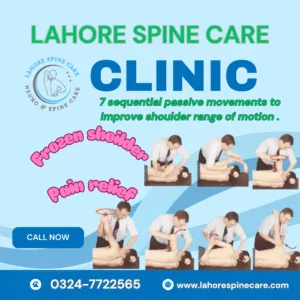
LAHORE SPINE CARE
Table of Contents
ToggleFrom Stress to Muscle Tightness: Understanding the Cycle and How to Break It
In our modern world, stress has become almost a constant companion for many. Whether it’s from work pressures, family responsibilities, or everyday challenges, stress affects nearly every aspect of our lives. But stress doesn’t just stay confined to our minds; it often manifests physically, particularly through muscle tightness. Understanding this cycle is crucial for breaking free from the pain and discomfort that stress can cause. Let’s delve into the cycle of stress and muscle tightness and explore practical steps to break it.
The Stress-Muscle Tightness Cycle
- The Stress Response When you encounter a stressor, your body activates the “fight or flight” response. This involves the release of stress hormones such as cortisol and adrenaline, which prepare you to respond to the perceived threat. These hormones cause various physiological changes, including increased heart rate, elevated blood pressure, and muscle tension.
- Muscle Contraction The immediate effect of these stress hormones is muscle contraction. This is your body’s way of getting ready to act quickly. However, when stress becomes a regular part of life, your muscles can remain in a contracted state for extended periods. This chronic tension often leads to stiffness and discomfort.
- Posture and Movement Stress can also impact your posture. Under stress, you might slouch, hunch, or adopt other postural habits that contribute to muscle tightness. For example, sitting at a desk for long periods with poor posture can exacerbate the tightness in your neck, shoulders, and back.
- Feedback Loop Muscle tightness often creates a feedback loop. Tight muscles can lead to pain and discomfort, which in turn increases stress levels. This cycle of discomfort and stress can become self-perpetuating, making it challenging to break free from the physical and emotional strain.

Breaking the Cycle: Strategies for Relief
- Recognize and Address Stressors The first step in breaking the cycle is to identify and address the sources of your stress. This could involve time management, seeking support from friends or family, or even professional counseling. Addressing the root causes of stress can reduce the frequency and intensity of stress responses.
- Incorporate Physical Activity Regular exercise is a powerful tool in managing stress and reducing muscle tightness. Activities like yoga, stretching, and aerobic exercises help release endorphins, which counteract stress hormones and relax tight muscles. Aim for at least 30 minutes of moderate exercise most days of the week.
- Practice Mindfulness and Relaxation Mindfulness techniques, such as deep breathing, meditation, and progressive muscle relaxation, can help manage stress and alleviate muscle tension. These practices promote relaxation and can break the feedback loop by reducing overall stress levels and muscle tightness.
- Adopt Ergonomic Practices If your stress-related muscle tightness is exacerbated by poor posture or ergonomics, make adjustments to your workspace. Use an ergonomic chair, ensure your computer screen is at eye level, and take regular breaks to stretch and move. Proper ergonomics can prevent further strain and discomfort.
- Stretch and Massage Regular stretching can alleviate muscle tightness and improve flexibility. Incorporate stretches into your daily routine, particularly for areas commonly affected by stress, such as the neck, shoulders, and back. Massage therapy can also provide targeted relief and promote relaxation in tense muscles.
- Maintain a Healthy Lifestyle A balanced diet, adequate hydration, and sufficient sleep are essential for managing stress and muscle tightness. Eating well and staying hydrated support overall health and muscle function, while good sleep hygiene helps your body recover from daily stressors.

When to Seek Professional Help
If muscle tightness persists despite your efforts or is accompanied by severe pain, it may be time to seek professional help. Healthcare providers such as physical therapists, chiropractors, or mental health professionals can offer tailored treatments and strategies to address your specific needs.
Conclusion
The cycle from stress to muscle tightness is a common yet often overlooked issue. By understanding how stress translates into physical tension and taking proactive steps to address both stress and muscle tightness, you can break free from the cycle of discomfort. Implementing strategies like regular exercise, mindfulness, ergonomic adjustments, and professional support can lead to significant improvements in both physical and emotional well-being. Taking control of this cycle not only helps in managing immediate discomfort but also contributes to a healthier, more balanced lifestyle in the long run.



how to choose the right shoe for spine health

Celebrating World Physiotherapy Day 2025: Advancements and Innovations in Rehabilitation

Tehmina Arshad: Expert Speech and Language Pathologist

Independence Day of Pakistan 2025—A Celebration of Freedom and Unity

Exploring the Impact of Research Publications by Dr. Ejaz Danish: A Physiotherapist’s Contribution to the Field
LAHORE SPINE CARE is proudly powered by WordPress